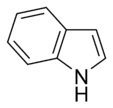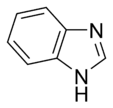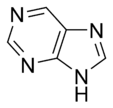Simple aromatic rings facts for kids
Simple aromatic rings, also known as simple arenes or simple aromatics, are aromatic organic compounds. They consist only of a conjugated planar ring system with delocalized pi electron clouds. Many simple aromatic rings have trivial names. They are usually found as substructures of more complex molecules ("substituted aromatics"). Typical simple aromatic compounds are benzene, indole, and cyclotetradecaheptaene.
Simple aromatic rings with non-carbon ring atoms are called "heterocyclic". For example, rings can include oxygen, nitrogen, or sulfur. Molecules with one ring are called monocyclic as in benzene. Molecules with two rings are called bicyclic as in naphthalene. Molecules with more than two rings are called polycyclic as in anthracene. Simple monocyclic aromatic rings are usually five-membered rings like pyrrole or six-membered rings like pyridine. Fused aromatic rings consist of monocyclic rings that share their connecting bonds.
Contents
|
||||||||||||||||||||||||||||||||||||||||||||||||||
Heterocyclic aromatic rings
The nitrogen (N)-containing aromatic rings can be separated into basic aromatic rings that are easily protonated, and form aromatic cations and salts (e.g., pyridinium), and non-basic aromatic rings.
- In the basic aromatic rings, the lone pair of electrons is not part of the aromatic system and extends in the plane of the ring. This lone pair is responsible for the basicityof these nitrogenous bases, similar to the nitrogen atom in amines. In these compounds, the nitrogen atom is not connected to a hydrogen atom. Examples of basic aromatic rings are pyridine or quinoline. Several aromatic rings contain basic as well as non-basic nitrogen atoms, e.g., imidazole and purine.
- In the non-basic rings, the lone pair of electrons of the nitrogen atom is delocalized and contributes to the aromatic pi electron system. In these compounds, the nitrogen atom is connected to a hydrogen atom. Examples of non-basic nitrogen-containing aromatic rings are pyrrole and indole.
In the oxygen- and sulfur-containing aromatic rings, one of the electron pairs of the heteroatoms contributes to the aromatic system (similar to the non-basic nitrogen-containing rings). The second lone pair extends in the plane of the ring (similar to the basic nitrogen-containing rings).
Criteria for aromaticity
All of these molecules meet the following criteria:
- Molecule must be cyclic.
- Every atom in the ring must have a p orbital, which overlaps with p orbitals on either side (completely conjugated).
- Molecule must be planar.
- It must contain an odd number of pairs of pi electrons; must satisfy Huckel's rule: (4n+2) pi electrons, where n is an integer starting at zero.
In contrast, molecules with 4n pi electrons are antiaromatic.
Related pages
- Polycyclic aromatic compounds
- Polycyclic aromatic hydrocarbons (PAH)
See also
 In Spanish: Anillo aromático simple para niños
In Spanish: Anillo aromático simple para niños


































